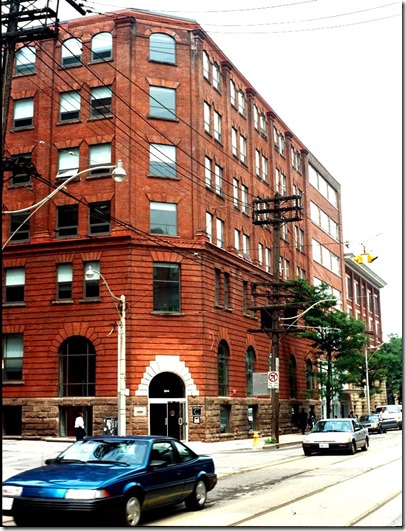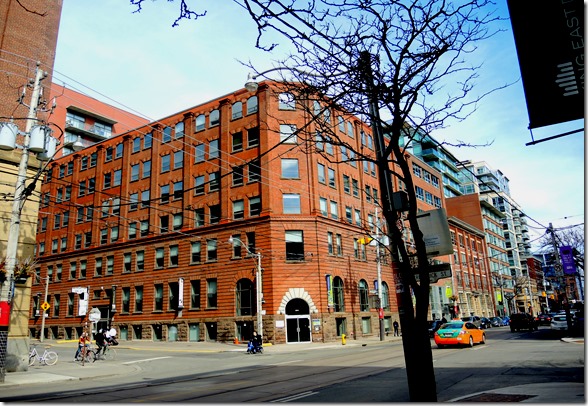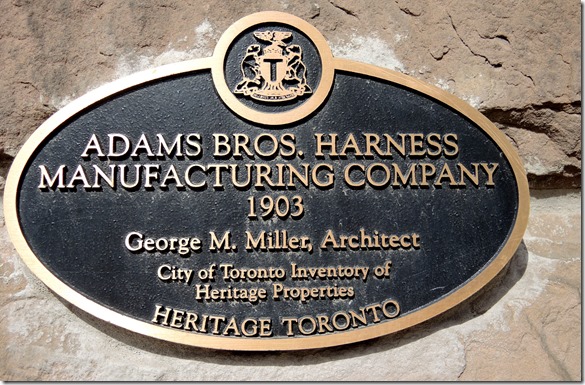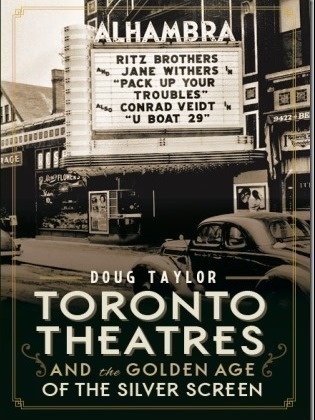The Quetton St. George House on King Street in 1885, after its brick facades had been covered with stucco. Toronto Public Library, r-2655.
Few personalities from the early days of the town of York (Toronto) possess such an interesting background as that of Laurent Quetton St. George (born, Laurent Quet). He built York’s first brick house on the northeast corner of Frederick and King Streets, between the years 1807 and 1811. Today, the address of the site is 204 King East.
Laurent Quet (Laurent Quetton St. George) was born in France in 1771, his family a part of the minor nobility who were merchants and served in the military. When the French Revolution began in 1789, at age 18, he fought for the King of France. In 1791, he voluntarily went into exile in England, where he joined a guerrilla group of Frenchmen who had fled their native land. Later the same year, he returned to France, serving under the command of Comte de Puisaye. The Comte’s forces were defeated in 1793 and Quetton St. George returned to England. In 1796, he anglicised his name and commenced signing it as Quetton St. George, rather than Laurent Quet.
In 1798, the British Crown gave Comte de Puisaye a land grant in York County in Upper Canada, about 26 miles north of York. The farmland was on either side of Yonge Street, where Elgin Mills Road is located today. Puisaye’s intention was to found a colony loyal to the French king, and gave Quetton St. George a parcel of the land. However, by 1802, the colony collapsed as many of the colonists had returned to Europe. They discovered Canadian winters too harsh.
In partnership with another French officer, Quetton became a general merchant, importing goods and trading them for furs with the Mississauga Indians. In 1802, they relocated their business to Niagara-on-the-Lake, but by the end of the year, they moved their headquarters to York. The town’s location was advantageous for their enterprise as it was situated on the lake, allowing easy access to the shipping routes necessary for importing goods.
Next, St. George ended his business partnership and became the sole proprietor. He commenced selling supplies to the provincial government in York, as well as to the British army. Much of his income was soon derived from these sources, under the business name of “Quetton St. George and Company.” In the years ahead, in partnership with various businessmen, he established branches in Amherstburg, Niagara, Kingston and Dundas. In York, his chief rivals in the retail trade were Alexander Wood and William Allen. However, despite his success, St. George was never fully embraced by the elite of York. It has been suggested that this was because many of them owed him money that they were unable to repay.
In 1807, Quetton began courting Anne Powell, the daughter of William Drummer Powell, a prominent citizen of York. Her mother considered Quetton St. George “an adventurer” and unworthy of her daughter. To improve his standing in York, St. George decided to erect a brick house, the first such building in the town. At the time, all the dwellings were of wood, in a town of only about 700 residents. York did not yet extend west of Yonge Street or north of Lot Street (today’s Queen Street), so a brick house was viewed as a positive sign.
The site of the house was to be on the north side of King Street, where St. George owned three building lots. Thus, it was to be situated on the town’s main commercial street and most prestigious residential area. The digging of the foundations began in 1807, and it is thought that the red bricks for the structure were made from clay dug on the site. This is disputed by some reference sources as there were professional brick-makers in York at the time, as York’s first legislative assembly had been constructed of bricks in 1797. The house was completed in 1810, or early-1811 at the latest. However, he was never allowed to marry Anne.
St. George’s house was designed by Dr. William Warren Baldwin in the Georgian style, its symmetrical facade containing nine rectangular windows facing King Street. The structure was basically a rectangular box with simple unadorned lines, a low hip roof, and a portico (porch) on its south side. The porch was in the Greek style, it roof supported by two pairs of slender columns, topped with Ionic scrolls. The portico was likely added a few years after the house was built.
It is thought that in addition to a mason, a skilled carpenter was employed since the wood trim on the house was of an exceptionally high quality. Unlike the mansion of Bishop Strachan (built in 1818), there was no triangular pediment above the front facade. The brickwork contained no decorative patterns, and later in the century, the exterior walls were covered with stucco.
On the second floor, there was a Palladian window in the centre position, with a fan-shaped window above it. It was a simple but elegant refinement to an otherwise plain facade. In the interior, there was a central hallway, likely with the parlour on one side of it and a dining room on the other. In most Georgian homes. a grand staircase led to the second storey.
The house provided St. George with the necessary requirements to maintain a residence and a place of business. On the second floor, there were living quarters for himself and his clerks. In the basement was a storeroom for his stock of goods, and on the ground floor a shop and office. When the Americans invaded York in April 1813, the house was sacked but not torched. At the time, Quetton St, George was away from York on business.
St. George remained a resident of York until 1815, when Napoleon was defeated and the French monarchy restored. He then returned to England and then France, where he assumed the title of Chevalier de St. Louis. In 1820, he sold the shares of his company in Upper Canada to Dr. W. W. Baldwin, John Baldwin, and Jules Quesnel. Baldwin lived in the house, but rented a section of it to the Canada Company, a semi-government development company that sold off crown land. After Baldwin died, his widow continued in residence. In 1895, the Canada Company vacated the premises and it became a pharmaceutical company. Next, it was converted into a boarding house, then a junk shop, and finally a tenement. By the turn of the 20th century, the property was in poor condition as it had not been maintained. It was demolished in 1904, and Toronto’s first brick residence disappeared forever.
A seven-storey warehouse was erected on the site for the Adams Harness Company. This building has since changed hands several times, but remains in existence. Today, the only reminder of Quetton St. George is St. George Street, which was named by William Baldwin after his friend, Quetton St. George. The St. George subway station on the Spadina/University line is named after the street.
Sources: “Lost Toronto” by William Dendy – www.biographic.ca – www.thestar.com— torontohistory.net—
Location of the Quetton St. George house on the northeast corner of Frederick and King Street East.
The Quetton St. George House in 1895. Toronto Public Library, r-2862.
Watercolour sketch of the Quetton St. George House. Painted in 1912, it was created from the artist’s memory, as it depicts the house prior to its walls being covered with stucco. From the collection of the Toronto Public Library, r-2917.
The northeast corner of Frederick and King Street East in 1994, the site of the demolished Quetton St. George house. Toronto Archives, F1465, S.0182, Id. 0020.
Building on the site of the Quetton St. George House, March 2016.
This is the only historic plaque on the building. There is nothing to recognize that Toronto’s first brick house once occupied the site.
To view the Home Page for this blog: https://tayloronhistory.com/
For more information about the topics explored on this blog:
https://tayloronhistory.com/2016/03/02/tayloronhistory-comcheck-it-out/
The publication entitled, “Toronto’s Theatres and the Golden Age of the Silver Screen,” was written by the author of this blog. It explores 50 of Toronto’s old theatres and contains over 80 archival photographs of the facades, marquees and interiors of the theatres. It relates anecdotes and stories by the author and others who experienced these grand old movie houses.
To place an order for this book:
Book also available in Chapter/Indigo, the Bell Lightbox Book Shop, and by phoning University of Toronto Press, Distribution: 416-667-7791 (ISBN 978.1.62619.450.2)
Another book, published by Dundurn Press, containing 80 of Toronto’s former movie theatres will be released in June, 2016. It is entitled, “Toronto’s Movie Theatres of Yesteryear—Brought Back to Thrill You Again.” It contains over 125 archival photographs and relates interesting anecdotes about these grand old theatres and their fascinating history.
Another publication, “Toronto Then and Now,” published by Pavilion Press (London, England) explores 75 of the city’s heritage sites. This book will be released on June 1, 2016. For further information follow the link to Amazon.com here or to contact the publisher directly:
http://www.ipgbook.com/toronto–then-and-now—products-9781910904077.php?page_id=21.
![1885, pictures-r-2655[1] 1885, pictures-r-2655[1]](https://tayloronhistory.com/wp-content/uploads/2016/02/1885-pictures-r-26551_thumb.jpg)
![data=RfCSdfNZ0LFPrHSm0ublXdzhdrDFhtmHhN1u-gM,wSNog0sA-tRWo0T3b2SlwN_gvASLtzc6LVGD-gkfpmP4o9dgZ45IXe4zhHJuQgNxVJ7ANQCFsrw7nHnnb0EJsGOBcm0NOjyZ6CKRZFv[1].png data=RfCSdfNZ0LFPrHSm0ublXdzhdrDFhtmHhN1u-gM,wSNog0sA-tRWo0T3b2SlwN_gvASLtzc6LVGD-gkfpmP4o9dgZ45IXe4zhHJuQgNxVJ7ANQCFsrw7nHnnb0EJsGOBcm0NOjyZ6CKRZFv[1].png](https://tayloronhistory.com/wp-content/uploads/2016/02/datarfcsdfnz0lfprhsm0ublxdzhdrdfhtmhhn1u-gmwsnog0sa-trwo0t3b2slwn_gvasltzc6lvgd-gkfpmp4o9dgz45ix1.jpg)
![1895 pictures-r-2862[1] 1895 pictures-r-2862[1]](https://tayloronhistory.com/wp-content/uploads/2016/02/1895-pictures-r-28621_thumb.jpg)
![house 1866-1949, sketch 1912, TRL. pictures-r-2917[1] house 1866-1949, sketch 1912, TRL. pictures-r-2917[1]](https://tayloronhistory.com/wp-content/uploads/2016/02/house-1866-1949-sketch-1912-trl-pictures-r-29171_thumb.jpg)







